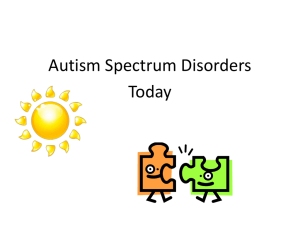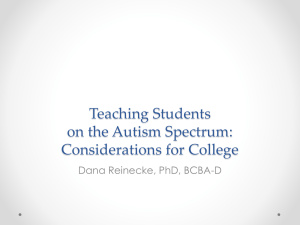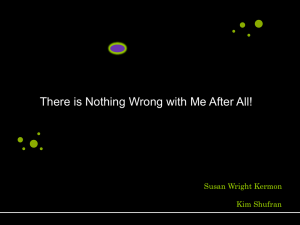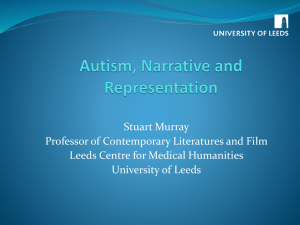Autistic-Spectrum-Disorders-Current
advertisement
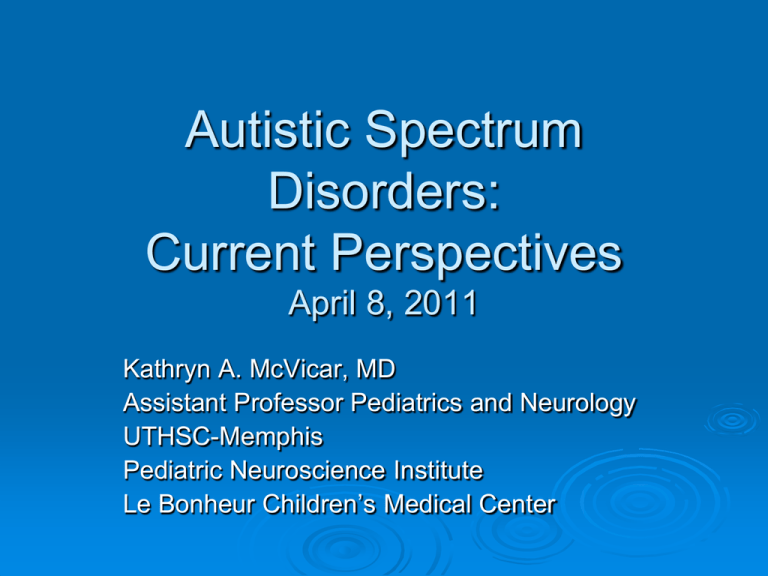
Autistic Spectrum Disorders: Current Perspectives April 8, 2011 Kathryn A. McVicar, MD Assistant Professor Pediatrics and Neurology UTHSC-Memphis Pediatric Neuroscience Institute Le Bonheur Children’s Medical Center Introduction Epidemiology History Clinical Presentation Epilepsy Sleep disturbance Structural brain differences Genetic work suggesting future treatments Current treatment Conclusions Epidemiology Prevalence Initially thought to be 1/1,000 Reevaluation/Change in definitions • DSM IV • International Classification of Diseases (ICD-10) Current estimates 1/99 (CDC 2010) 3-4:1 boys to girls History Kanner in US/Asperger in Austria 1943 Simultaneously described autism phenotype • Kanner- “autistic disturbances of affective contact” 11 children-Mental retardation • Asperger-”autistic phsychosis” 4 boys-No mental retardation • Behaviors Social remoteness Obsessiveness Stereotypy Echolalia History DSM 1952, 1968 Autism as psychosis Concept of ‘refrigerator Mom’ Child left untreated Mother given psychotherapy to improve ‘bonding’ with child Above a clue to genetic component History DSM III 1980 First use of term pervasive developmental disorders …”distortions in the development of multiple basic psychological functions that are involved in the development of social skills and language such as attention, perception, reality testing, and motor movements.” History Lorna Wing 1988 Concept of the “Autistic Continuum” • No clear cut offs Term “Autistic Spectrum” (Autistic Spectrum Disorders, ASD) came into use increasingly after this Clinical presentation Core deficits: Reciprocal social interactions Verbal and nonverbal communication Restricted and repetitive behaviors and interests Examples of reciprocal attention Lack of reciprocal attention Easily overwhelmed Pointing with eye contact Gestures, but NOT communicating Clinical presentation Receptive language Pragmatics absent or diminished • Lacks comprehension of communicative intent of others Expressive language Semantics absent or diminished • Lacks use of language/gestures with intent to communicate Clinical presentation Motor apraxia ‘Clumsy’ ‘Stiff’ Abnormal play No imagination No pretending Prefers to play alone Clinical presentation Overlap and co-morbidity with Mental retardation Developmental dysphasia Obsessive Compulsive Disorder Schizoid personality Bi-polar Disorder ADHD Sleep disturbance Behavior disorder Regression Up to 1/3 with ASD will regress Mean age at regression • 18-24 months Shinnar et al, 2001 McVicar et, 2005 • 41.4 months Jones LA and Campbell JM, 2010 Epilepsy Comorbid epilespy 5-38% Rossi PG et al. Brain Develop. 1995;17:169-74 Tuchman and Rapin. Lancet Neurol. 2002;1:352-58 Danielsson S et al. Epilepsia. 2005;46:918-23 Bimodal incidence of epilepsy Infancy to age 5 Adolescence (>10 years) Volkmar and Nelson. J Am Acad Child Adolesc Psychiatry. 1990;29:127-29 Epilepsy Cumulative probability of epilepsy Autism alone • 2% at 5 years • 8% at 10 years Autism with severe mental retardation (MR) • 7% at 1 year • 16% at 5 years • 27% at 10 years Autism with MR and cerebral palsy (CP) • 20% at 1 year • 35% at 5 years • 67% at 10 years Tuchman and Rapin. Lancet Neurol. 2002;1:352-58 Epilepsy Epilepsy persists into adult life Remission in 16% Danielsson S et al. Epilepsia. 2005;46:918-23 Epilepsy 10 year follow up (n=30) 25% epileptic seizures 68% epileptiform EEG prior to seizure onset 18% epileptiform EEG/NO SEIZURES Epileptic group Lower IQ Lower social maturity score ↑ frequency of psychotropic medication tx Hara H. Brain Dev. 2007;29:486-490 Sleep Sleep difficulties in children with autism 56%-68% Clements J et al. J Child Psychol Psychiat. 1986:27:399-407 Hoshino Y et al. Folia Psychiatrica et Neurologica Japonica. 1984:38:45-51 Wiggs L and Stores G. J Intell Dis Res. 1996;40:518-28 Up to 89% in high-functioning if ‘past’ included Richdale AL and Prior MF. Eur Child Adoles Psychiat. 1995;4:175-86 Sleep Disturbances More variable sleep patterns Sleep onset Sleep maintenance Irregular sleep-wake patterns Hoshino Y et al. Folia Psychiatrica et Neurologica Japonica. 1984:38:45-51 Sleep Disturbance and Intensity of ASD Symptoms Parent report of sleep problems Fewer hours of sleep predicted Stereotypic behavior predicated by ↑ autism scores Social skills deficits Fewer hours of sleep Screaming during night Predicted communication problems ↑ sensitivity to environmental stimuli in bedroom Screaming at night Schreck KA et al. Research Dev Dis. 2004;255:57-66 Sleep Behaviors and Quality of Sleep ASD Behavioral insomnia sleep-onset type Insomnia due to PDD Picked up by questionnaire and actigraphy Souders MC et al. Sleep behaviors and sleep quality in children with autism spectrum disorders. Sleep. 2009 Dec 1;32(12):1566-78 Sleep Treatment Melatonin (up to 6 mg) to treat insomnia Retrospective review of single pediatrician • n=107 children • 2-18 year-olds Parental report of change with tx Melatonin dose range 0.75-6mg Andersen IM et al. J Child Neurol. 2008;23(5):482-5 Sleep Treatment Results 25% no further sleep concerns 60% improved sleep, continued concerns 13% sleep problems, major concern 1% worse sleep with melatonin 1% undetermined response Andersen IM et al. J Child Neurol. 2008;23(5):482-5 Gastrointestinal symptoms in ASD GI symptoms 52% of ASD 7% TD age-matched healthy siblings (p<.001) ASD with irritability more likely with reflux eosphagitis 43% with GERD vs 17% without GERD Horvath K and Perman JA, 2002 Abdominal pain and discomfort in ASD Vocal Behaviors Throat clearing, swallowing, tics, etc. Screaming, sobbing for unknown reason, sighing, whining, moaning, groaning Delayed echolalia-repeating what may have been asked of them in the past • Child saying “DOES YOUR TUMMY HURT?” Direct verbalizations • Child saying “tummy hurts”, etc with/without pointing Taken from Table 2 Pediatrics Vol 125, Supplement 1, January 2010:pg S4 Abdominal pain and discomfort in ASD Motor Behaviors Grimacing, gritting teeth, wincing Constant eating/drinking/swallowing Mouthing behaviors/pica Pressure to abdomen Taken from Table 2 Pediatrics Vol 125, Supplement 1, January 2010:pg S4 Abdominal pain and discomfort in ASD Changes in overall state Sleep disturbance Increased irritability Oppositional behavior Taken from Table 2 Pediatrics Vol 125, Supplement 1, January 2010:pg S4 Diagnostic considerations for GI symptoms in ASD Sleep disturbance Self-injurious behavior, tantrums, aggression, oppositional behavior GERD Constipation GERD Gastritis Intestinal inflammation Chronic diarrhea (≥3 loose stools daily for >2 weeks) Malabsorption Maldigestion Taken from Table 2 Pediatrics Vol 125, Supplement 1, January 2010:pg S4 Diagnostic considerations for GI symptoms in ASD Flatulence and/or bloating Constipation Lactose intolerance Enteric infection • Giardia • Cryptosporidium Taken from Table 2 Pediatrics Vol 125, Supplement 1, January 2010:pg S4 How does this happen? Structural brain differences Cortical Impaired ability to integrate information Facial connectivity perception problems Impaired social interaction Imitation problems/Mirror neurons Contributes to learning delay Contributes to disorders of communication and contact Cortical connectivity Corpus callosum smaller volumes: 24 boys with autism (10.0 +/- 3.3 yr) 26 control boys (11.0 +/- 2.5 yrs) 3 Tesla MRI Localize regions of callosal thinning in autism Vidal CN, Nicolson R, Thompson PM, et al. Mapping corpus callosum deficits in autism: an index of aberrant cortical connectivity. Biol Psychiatry. 2006 Aug 1;60(3):218-25 Cortical Connectivity Significant ↓ Total callosal area Anterior 1/3 of the CC Splenium and genu of the CC Suggest aberrant connections of cortical regions Vidal CN, Nicolson R, Thompson PM, et al. Mapping corpus callosum deficits in autism: an index of aberrant cortical connectivity. Biol Psychiatry. 2006 Aug 1;60(3):218-25 Corpus Callosum Cortical Connectivity DTI and volumetric measurements of the total CC and subregions Results: Significant differences • • • • volume, fractional anisotropy mean diffusivity radial diffusivity Alexander AL, Lee JE, Lainhart JE. Diffusion tensor imaging of the corpus callosum in Autism. Neuroimage. 2007 Jan 1;34(1):61-73 Cortical Connectivity Group differences driven by a subgroup of the autism group • • • • • small corpus callosum volumes ↑ mean diffusivity ↓ anisotropy ↑ radial diffusivity Significantly ↓ performance IQ measures Alexander AL, Lee JE, Lainhart JE. Diffusion tensor imaging of the corpus callosum in Autism. Neuroimage. 2007 Jan 1;34(1):61-73. Epub 2006 Oct 4. Facial Perception Hypoactive in autism Fusiform gyrus (FG) Cortical regions supporting face processing 7 post-mortem autism brains 10 controls FG analyzed van Kooten IA, Palmen SJ, Schmitz C. Neurons in the fusiform gyrus are fewer and smaller in autism. Brain. 2008 Apr;131(Pt 4):987-99 Facial Perception Significant ↓ Neuron densities layer III Association cortex Total neuron numbers layers III, V and VI Association cortex Sensory in from thalamus Cortical in to thalamus Mean perikaryal volumes of neurons layers V and VI van Kooten IA, Palmen SJ, Schmitz C. Neurons in the fusiform gyrus are fewer and smaller in autism. Brain. 2008 Apr;131(Pt 4):987-99 Inability to imitate/Mirror neurons EEG activity during videos showing actions or still scenes 14 right-handed children with autism • Mean age 5 years 3 months 14 right-handed, age- and gender-matched typical children • Mean age 7 years 11 months Martineau J, Cochin S, Barthelemy C, et al. Impaired cortical activation in autistic children: is the mirror neuron system involved? Int J Psychophysiol. 2008 Apr;68(1):35-40 Inability to imitate/Mirror neurons Results: Typical children: Desynchronization of the EEG with observation of human actions • motor cerebral cortex • frontal and temporal areas With autism: No desynchronization • Inversion of the pattern of hemispheric activation was found in autistic children • ↑ cortical activity RT hemisphere posteriorly, including the centro-parietal and temporo-occipital sites Martineau J, Cochin S, Barthelemy C, et al. Impaired cortical activation in autistic children: is the mirror neuron system involved? Int J Psychophysiol. 2008 Apr;68(1):35-40 EEG Sample Brain Clues from other diseases with an autism phenotype Fragile X Genetics FMR1 gene FMR1 (fragile X mental retardation 1) X chromosome FMR1 CGG repeat Loss of RNA-binding protein Role in mRNA transport and translational regulation • Affects synaptic plasticity Peng et al. RNA and microRNAs in fragile X mental retardation Nature Cell Biology 6, 1048 - 1053 (2004) doi:10.1038/ncb1104-1048 Fragile X Genetics FMR1 gene AMPA receptor trafficking →driving process for synaptic plasticity Normal system, process learning and memory Abnormal system, • problems with learning and memory • LTP disruption Nakamoto et al. Fragile X mental retardation protein deficiency leads to excessive mGluR5-dependent internalization of AMPA receptors. Proceedings of the National Academy of Sciences of the United States of America. August 2007. ↓ mGluR5 signaling can reverse fragile X sx Potential treatment with mGluR5 antagonists Fulfilling the Promise of Molecular Medicine In Autism. M. Bear*, MIT Presented IMFAR 2009. mGluR5 antagonists Safety and efficacy in humans Phase II trial of fenobam in adults with FXS N=12 adults (mean age 23.9 yrs) • UC Davis MIND Institute • RUSH, University in Chicago All tolerated single dose without significant SE 50% had ≥ 20% improvement in prepulse inhibition (p = 0.03) Majority scored at ceiling on continuous performance task Not helpful in assessing medication benefits R. Hagerman et al. Trial of fenobam, an mGluR5 antagonist, in adults with Fragile X Syndrome. JIDR; Vol 52 (10):814. Neurofibromatosis 1 Neurofibromin Functions as a tumor suppressor Kweh F, Zheng M, Kurenova E, Wallace M, Golubovskaya V, Cance WG. Mol Carcinog. 2009 May 28 Neurofibromin deficiency Loss of regulation of signaling and intersecting pathways Acts on Actin cytoskeleton reorganization Cell motility and adhesion Larizza et al. Developmental abnormalities and cancer predisposition in neurofibromatosis type 1. Curr Mol Med. 2009 Jul;9(5):634-53 NF 1 Neurofibromin NF 1 Future Treatment NF1-Malignant Peripheral Nerve Sheath Tumor (MPNST) explant grown subcutaneously in NOD-SCID mice Rapamycin in low doses Inhibited human NF1-MPNST mTOR pathway activation Inhibited explant growth in vivo Without systemic toxicities Behavioral changes similar to ASD, improved Bhola P et al. Preclinical in vivo evaluation of rapamycin in human malignant peripheral nerve sheath explant xenograft. Int J Cancer. 2009 Jul 24 Rett disease Most common basis of autism in girls X-linked MECP 2 Deficit in synaptic maturation in the brain MeCP2 mutant mice Sparse dendritic spines ↓ PSD-95 in motor cortex pyramidal neurons ↓ synaptic amplitude in the same neurons Protracted cortical plasticity in vivo Tropea et al. Partial reversal of Rett syndrome-like symptoms in MeCP2 mutant mice. PNAS. Feb 2009; vol. 106 (6): 2029-2034 Rett disease mouse model ↑ brain weight Partially restores Spine density Synaptic amplitude ↑ PSD-95 Stabilizes cortical plasticity to wild-type levels IGF-1 a candidate for pharmacological treatment of Rett disease and other neurodevelopmental disorders Tropea et al. Partial reversal of Rett syndrome-like symptoms in MeCP2 mutant mice. PNAS. Feb 2009; vol. 106 (6): 2029-2034 IGF-1 in Autism Insulin-like growth factor-I (IGF-I) IGF-I levels measured in the CSF of 11 children with autism 4 girls 7 boys Mean age 3.8 years Compared levels in 11 control children Role in early brain development. 6 girls 5 boys mean age 3.8 years IGF-I in the CSF lower with autism (p=0.03) Vanhala et al. Low levels of insulin-like growth factor-1 in cerebrospinal fluid in children with autism. Dev Med & Child Neuro. 2001, 43;9:614-16 Rare syndromes with ASD co-occurrence Syndrome ASD co-diagnosis Gene mutation Angelman >50% UBE3A (maternal) Down syndrome >5%–15% Chromosome 21 triplication Fragile X >45%–70% FMR1 Neuro>4%A NF1/NF2 fibromatosis Macrocephaly >75% PTEN Potocki-Lupski >90% 17p duplications Rett >50% MECP2 Smith-Lemli>50%–75% DHCR7 Opitz Tuberous >40%–50% Sclerosis 22q13 deletion >90% PDD-NOS Timothy >75% Cell function References Protein degradation Multiple RNA trafficking PI3K signaling activity TSC1/TSC2 PI3K signaling activity Unknown Transcriptional regulation Cholesterol biosynthesis; Ras-mediated ERK signaling; PI3K signaling PI3K/mTOR signaling Microdeletions CACNA1C Multiple Calcium signaling Pat Levitt and Daniel B. Campbell. The genetic and neurobiologic compass points toward common signaling dysfunctionsin autism spectrum disorders. J Clin Invest. 2009 Apr;119(4):747-54 Protein functions with known genes associated with ASD Neuronal cell adhesion and/or synapse function Neuronal activity regulation Neurodevelopmental genes Sodium channel Calcium channel Neurotransmitter genes Mitochondrial Other Adapted from GeneReviews, http://www.genetest.org. Copyright, University of Washington, Seattle 1997-2010. Phenotypic variables that may define discrete (ASD) subgroups Morphology and growth Generalized dysmorphology 15–20% Macrocephaly 35% Microcephaly 5–15% Brain malformations 20% Medical/neurologic Seizures 25% EEG abn 50% Sleep disorder 65% Adapted from Miles JH. Autism spectrum disorders—A genetics review. Genetics in Medicine, April 2011. Phenotypic variables that may define discrete (ASD) subgroups Savant skills 5% Clinical course Age of onset Regressive onset 30% Adolescent/adult catatonic regression 17% Adapted from Miles JH. Autism spectrum disorders—A genetics review. Genetics in Medicine, April 2011. Phenotypic variables that may define discrete (ASD) subgroups Significant family history of related disorders ASD 25% Alcoholism 30% ADHD 70% Affective disorders Bipolar/major affective disorder 30% Adapted fromMiles JH. Autism spectrum disorders—A genetics review. Genetics in Medicine, April 2011. Phenotypic variables that may define discrete (ASD) subgroups Functionally defined variables IQ Response to therapy Adaptive behaviors (unclear) Outcome measures (poorly defined/unclear) Adapted fromMiles JH. Autism spectrum disorders—A genetics review. Genetics in Medicine, April 2011. Treatment Behavioral therapy Medical treatment of symptoms Sleep ADHD Aggression Anxiety Obsessive compulsive tendencies Epilepsy Constipation GERD Behavioral therapy Mainstay of therapy Consistently proven benefit Medication Therapies Start LOW and go SLOW Trial and error Caregiver participation Choices Permission to STOP Frequent appointments WITH BEHAVIORAL THERAPY Conclusions ASD often present as speech and language delay Any loss of language or behavioral function needs to be evaluated promptly ASD caused by abnormal /different brains with abnormal/different brain function Treatment is symptomatic Conclusions Behavioral therapy is the BEST intervention Definitive medical therapy based on nerve cell functioning may be close



